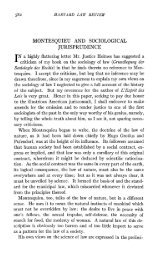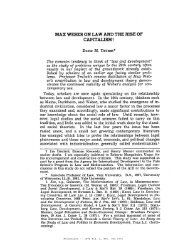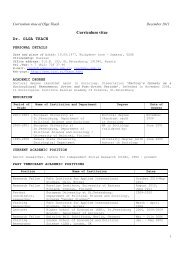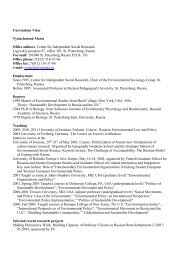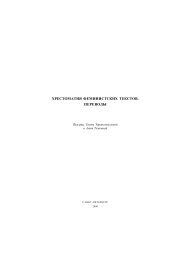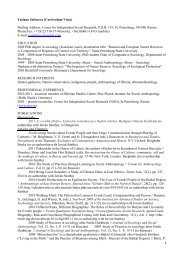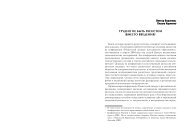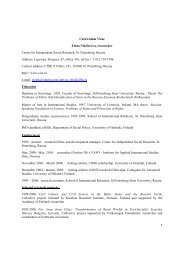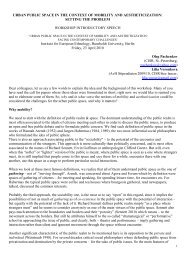who's afraid of legal pluralism?
who's afraid of legal pluralism?
who's afraid of legal pluralism?
Create successful ePaper yourself
Turn your PDF publications into a flip-book with our unique Google optimized e-Paper software.
WHO'S AFRAID OF LEGAL PLURALlSM?Franz von Benda-BeekmannJOURNAL OF LEGAL PLURALISM2002 - nr. 47eonstitutes 'differenee'? Third, 'how mueh different law' has to be involved, arule, a meehanism, an order or system? And fourth, what is meant by 'coexistenee'?,. PluralismThe idea <strong>of</strong> <strong>legal</strong> <strong>pluralism</strong> was an extension from !he analysis. <strong>of</strong>dualism/<strong>pluralism</strong> in colonial societies where it indicated asymmetrical power(and race) relationships between the white minority and the indigenous majority.Used first for characterising colonial economies, it was extended toO cultural andsocial <strong>pluralism</strong> (Boeke, Furnivall, Smith).32 Talking about '<strong>legal</strong> <strong>pluralism</strong>' in asense was a simple extension <strong>of</strong> this conceptual usage. However, in the firslsystematic treatment (Vanderlinden 1971), the implict complementary, even ifasymmetrical, character <strong>of</strong> such <strong>pluralism</strong> and its assumed or <strong>legal</strong>ly prescribedone-to-one relation between law-culture-ethnieity 33 was gradually broken up, byfocussing on the paraUel or duplicatory nature <strong>of</strong> <strong>legal</strong> <strong>pluralism</strong>. This drewattention to lhe faet that a same situation (and implictly the same people) could besubjeet 10 or be confronted with more than one <strong>legal</strong> order or meehanism, andthat people's actions could not be simply subsumed under 'their' law.1 think that it is useful to reserve the concept to the duplicatory, parallel character<strong>of</strong> <strong>legal</strong> forms or mechanisms, to distinguish it from more general andencompassing terms sueh as complexity or multiplicity. The question is:duplicatory 10 what? Vanderlinden originally (1971: 20) had stated that it wouldbe useful to reserve '<strong>pluralism</strong>' to a situation "where different <strong>legal</strong> mechanismspertained to the same situation" (see also Van den Berghe 1973). Thisconeeptualisation had been eriticized by J. Griffiths (1986), saying t!lat referenceto a 'same situation' was not usefuI beeause the notion <strong>of</strong> 'the same' wasconstrueted by normative categories. While this certainly is the case, the eriticismis miseoneeived. It results from Griffiths' particular understanding <strong>of</strong> thedifference between law as objeetified normative meaning (ideological, andtherefore not counting as 'real') and 'real' law/<strong>legal</strong> <strong>pluralism</strong> (see F. von BendaBeekmann 1988, 1997).34 Moreover, it seems to confine lawl<strong>legal</strong> <strong>pluralism</strong> tothose aspeets <strong>of</strong> law which attach eonsequenees .to 'faets'. But eonstitutive andeognitive categories are also part <strong>of</strong> law. Geertz's (1983) <strong>of</strong>ten quoted statement<strong>of</strong> "Iaw as one way <strong>of</strong> imagining the real" draws attention to the faet that law alsoconsists <strong>of</strong> cognitive coneeptions, and that with the help <strong>of</strong> <strong>legal</strong> conceptions'faets', or as I have said (1979, 1986), 'situation images', are established. 35 Legal<strong>pluralism</strong> should be seen to extend to al1 elements <strong>of</strong> law, to eonceptualisations <strong>of</strong><strong>legal</strong>ly constructed situation images, to standards <strong>of</strong> relevance and toconsequences.Take the instance <strong>of</strong> 'killing' as 'the same' situation. Different <strong>legal</strong> systems may,<strong>of</strong> course, have different eonsequences attached to such a situation image. But theway in which sueh situation image itself is constructed with (a.o.) <strong>legal</strong>assumptions about causality and evidenee can also be different. Just think <strong>of</strong>deaths caused by witchcraft. Contrariwise, what in one body <strong>of</strong> <strong>legal</strong> thought is'killing' may be 'accidental death' in the other. But we can also envisage that'killing' and 'consequenees' are more or less identical in two different <strong>legal</strong>systems, yet different beeause they are elements in different systems, havingdifferent bases <strong>of</strong> legitimation and <strong>of</strong>ten, through not necessarily so, differentauthoritiesfor dealing with sueh cases. Or take the <strong>legal</strong> treatment <strong>of</strong> kinshipobligations. The nature <strong>of</strong> obligations may vary between <strong>legal</strong> systems, but somay the definition <strong>of</strong> what kinds <strong>of</strong> persons are 'kin'. Or take the inslance <strong>of</strong>'Iand rights'. Rights may not only differ in charaeter and distribution over rightholders,also what 'Iand' ¡s, may be defined differently in different <strong>legal</strong> systems.With Woodman (1998) 1 would see no reason why all sueh situations should notbe treated as instances <strong>of</strong> <strong>legal</strong> <strong>pluralism</strong>o But it tells us tllat in order to see<strong>pluralism</strong> as duplicatory in relation to '!he same', we must ultimately relate32 Van den Berghe (1973) gives a good aceount <strong>of</strong> this intellectual history <strong>of</strong>"pluialism", as well <strong>of</strong> as lhe other intelleetual history rooted. in Americanpolitical theory where <strong>pluralism</strong> refers to an organizational plurality <strong>of</strong> relativelyautonomous (independent) organizations within the domain <strong>of</strong> the state" (Dahl1982:207). Starr and Collier's strange critique <strong>of</strong> other wrilers' assumptions about<strong>legal</strong> <strong>pluralism</strong> seems to refer to that tradition (see F. von Benda-Beckmann 1997:14).)3 See Greenhouse' s critique <strong>of</strong> the "corollary relationships between !heorganisation <strong>of</strong> <strong>legal</strong> orders and an on-the-ground schema <strong>of</strong> cultural identities(1998:65).34 Woodman (1998: 35, 37, 38) seems to make the same point, although he,similarly to Griffiths, seems to hold that in order for rules to be observable associal fact sorne extent <strong>of</strong> significance is required, rather !han a form <strong>of</strong> existenceas I have argued before. But l would hold that also rules not at all followed aresocial facts.35 See F. von Benda-Beckmann 1979. Barkun 1968, Cancian 1975, Von Wright1974 also emphasise the cognitive elements in law/rules. This should not Jet usforget that <strong>legal</strong> conceptions also provide standards <strong>of</strong> evaluntion <strong>of</strong> permissibleand valid action and transaction, and that others indicate what should or must (nol)be or be done, rather than imagine what has been,or is being done.- 60 - 61



